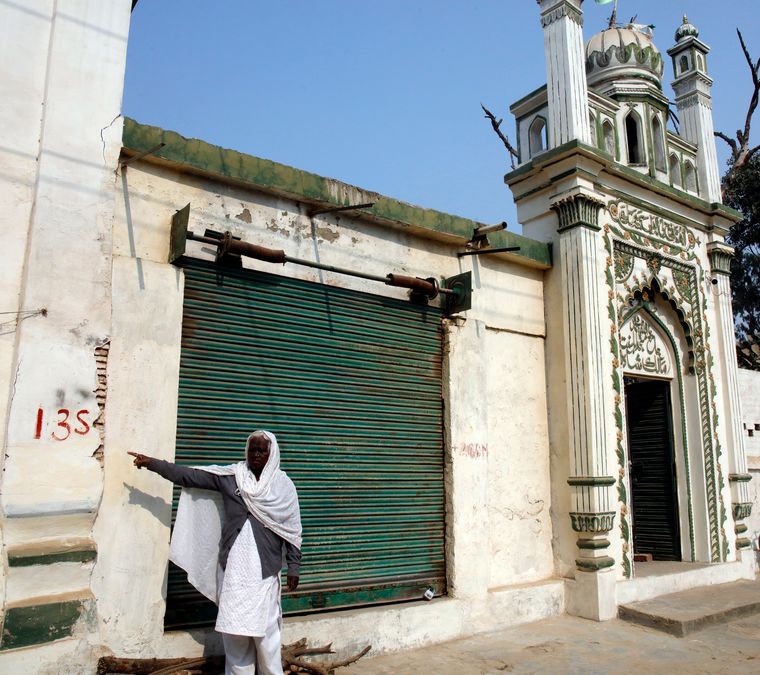Every morning, the sun rises over the Saryu to see a different Ayodhya.
‘Grand’ is the word often used to describe this changing land of Ram. It is a word that transcends words like ‘piety’ and ‘humility’ that are more associated with the king of Ayodhya, the most human of Hindu gods, one bereft of the spectacular powers of fellow deities.
One interpretation of the word ‘Ayodhya’ is that of a place which is not to be fought for, one that is invincible. But today there is a fight to draw up a different kind of Ayodhya where the comfort of the pilgrims is also taken care of.
The biggest of these plans is the laying of three corridors for easy access to the Ram Janmabhoomi. The longest of these is the 13km-long Ram Path that extends from Sahadatganj to the Lata Mangeshkar Chowk. Here, instead of getting into the city, pilgrims will take a road which connects them directly to the Sri Ram Janmabhoomi Teerth Kshetra.
The road could have been aligned differently as it is not part of any parikrama (circumambulation) route and, therefore, not sacrosanct. However, temples, mosques and gurdwaras on its path have been dismantled and rebuilding is not permitted. “We are still planning and might require more land,” is what local officials say. Nothing is committed on paper.
Devendra Nath Mishra of the Lal Mohariya Chah Bhaiyya Dharamshala―a property of the erstwhile royals of Nepal―struggled to describe how he felt about the destruction of the institution. “I am satisfied by the compensation, but I do not understand why the state is erasing heritage,” he said, pointing to the ornately carved boundary wall which had been demolished a while ago. “Foreigners are coming to see indigenous architecture, not modern doors,” he said.
One of the most puzzling of these demolitions has been that of the Singh Dwar, an iconic gateway to Hanumangarhi, the hilly fort from where Lord Hanuman keeps a watchful eye on the city. The dwar had carvings of the twin fish―the iconic symbol of Awadh’s might and glory, which is now used by the state government. It was one of Ayodhya’s most recognisable markers.
To this new Ayodhya, which is readying an international airport to welcome visitors from across the world, have come offerings from Janakpur in Nepal, the birthplace of Sita. These are in the form of two shaligrams, weighing 26 tonnes and 14 tonnes. Shaligrams are rocks found at the bed of the Kali Gandaki, a tributary of the Gandaki in Nepal. The ammonite fossil is worshipped as representative of Vishnu and the natural lines they have are known as their markers.
Satyendra Das, chief priest of the Sri Ram Janmabhoomi mandir, said, “Carving on these shila is ill advised as they are venerable in the form in which they exist.” It would also not have been easy to eke out forms from them.
Lallu Singh, BJP MP from the Faizabad (Ayodhya), said the plan for the city’s growth was an ever expanding one. “The railway station’s first phase was expected to cost Rs100 crore; it has now gone up to Rs240 crore. It will have the country’s largest air concourse which will connect platforms one to five,” he said. “A proposal of Rs360 crore has been sent to the Railway Board to develop the Cantonment railway station. The work of doubling the Barabanki-Ayodhya-Ambedkarnagar rail track route will finish by December this year.”
New roads are being built, new pipelines are being laid, tangled electricity wires are getting straightened, public conveniences are being created and the entire city is getting a makeover.
Then why are not all residents happy?
Nand Kumar Gupta, chairperson of the local traders association, said, “There were many sparsely populated alternatives available to make access to the temple easier. Those who have been displaced used to earn their livelihood here for generations. Once uprooted, they will not find a place as economically viable as this. The financial and the emotional void will never fill.”
Most shopkeepers who ply their trade do not own the buildings they operate from. The ownership is with erstwhile royalty, temple trusts or it is nazul land (government land not used for agriculture). Some 4,000 shopkeepers are affected by the demolition, but by the government’s calculation of ownership, only 700 qualify for compensation. Moreover, Ayodhya’s development does not square with the government’s plan to get the city the UNESCO heritage tag.
Ayodhya is the city of a thousand suns, the representative of the dynasty to which Ram belonged. Every evening, when the sun sets over Ayodhya, it might look at and wonder at its huge lookalike that has come up on the façade of the revamped railway station. And also feel curious about the Ayodhya it will return to the next dawn.




